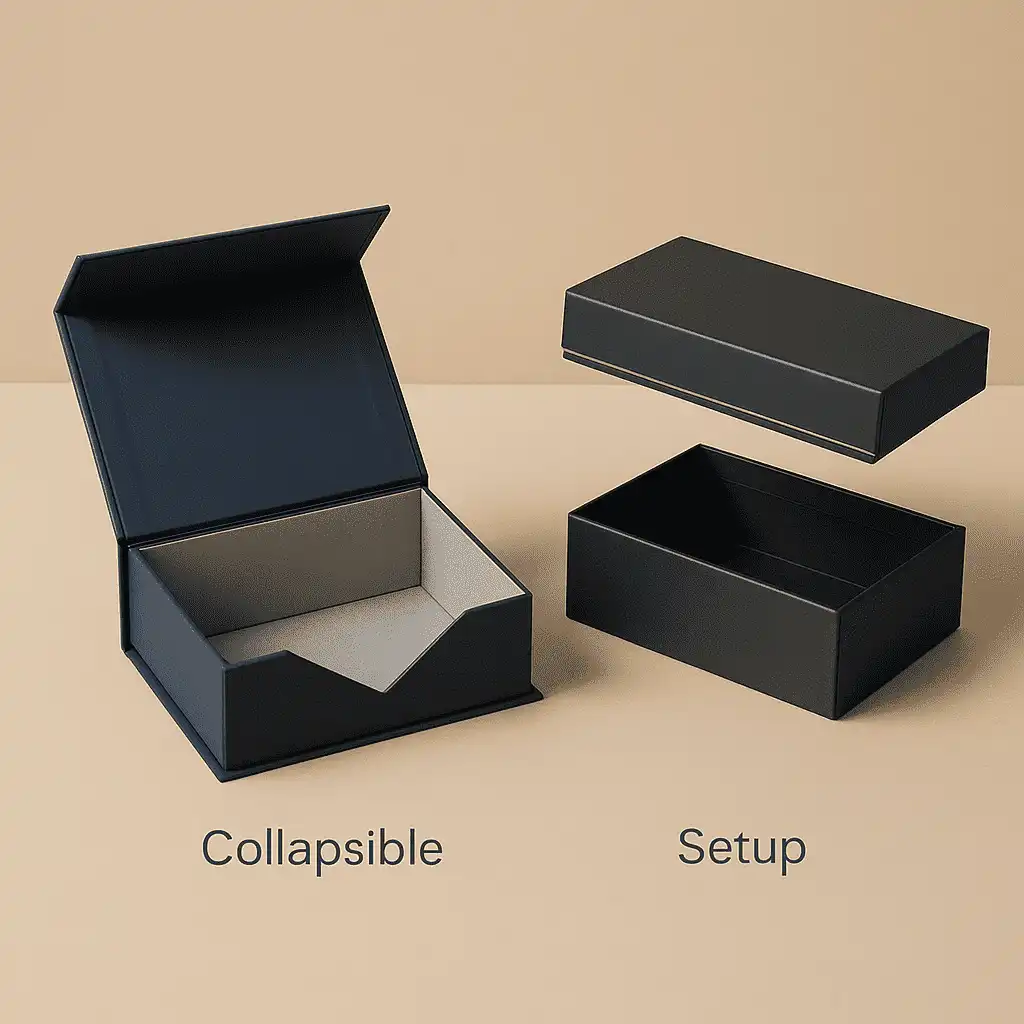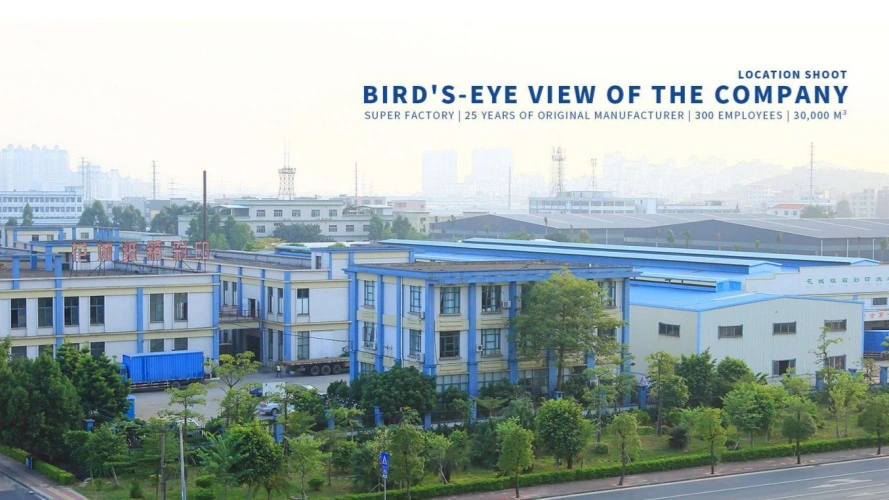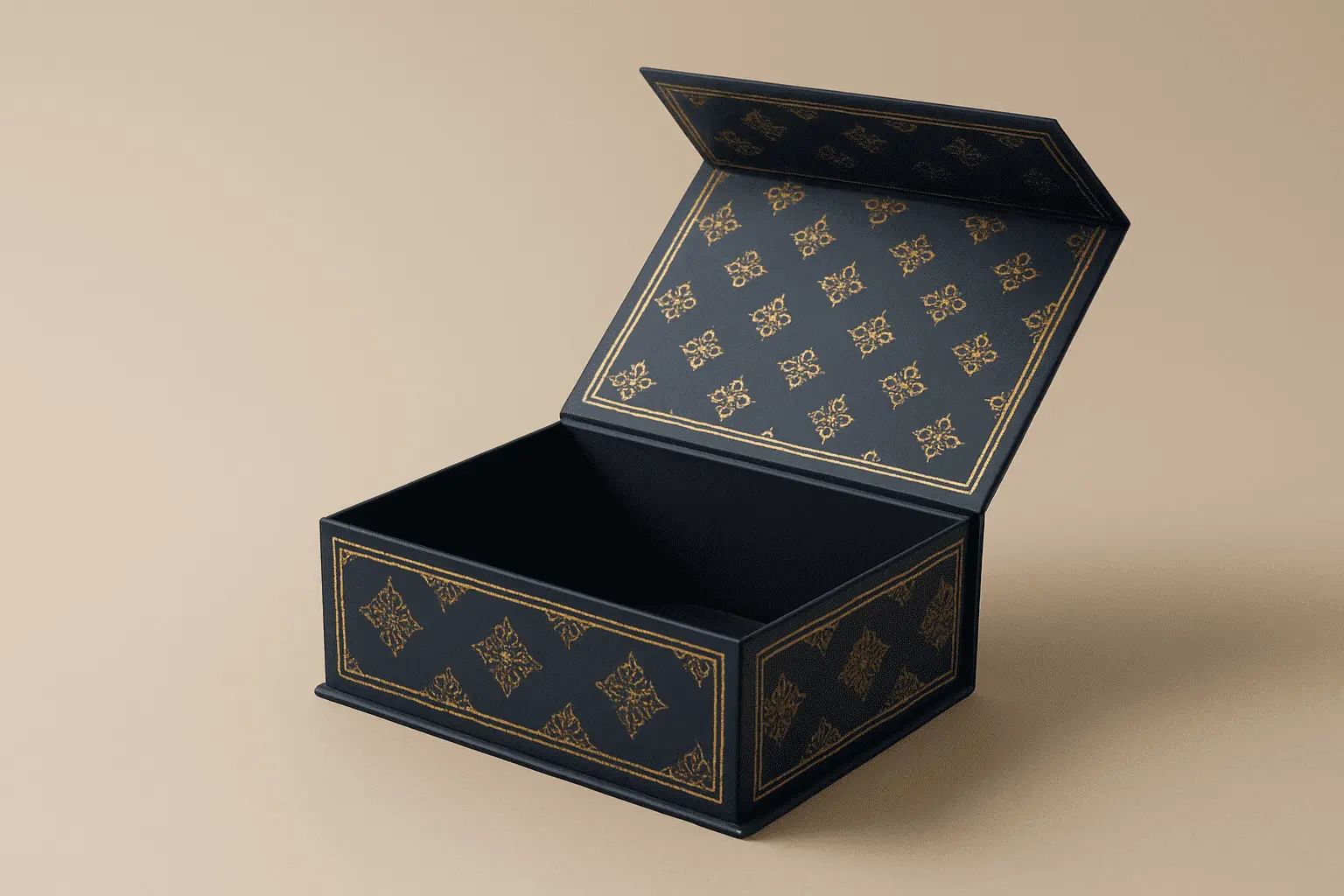Rigid Collapsible Box vs Setup Box: Choosing the Right Premium Option
Picture this scenario: You've invested heavily in developing a luxury product line that deserves premium presentation, but shipping costs are eating into your margins while warehouse space remains at a premium. You're torn between the undeniable elegance of traditional setup boxes and the practical advantages of modern alternatives. When selecting between a rigid collapsible box and a conventional setup box, understanding their structural differences, cost implications, and functional benefits becomes critical for brands seeking to balance luxury presentation with operational efficiency. This comprehensive guide examines both packaging solutions to help you make an informed decision that aligns with your brand positioning and business requirements.

Understanding Rigid Collapsible Box Construction and Benefits
The rigid collapsible box represents an innovative evolution in premium packaging design that addresses traditional limitations while maintaining luxury appeal. Unlike conventional setup boxes that arrive pre-assembled and consume significant storage space, collapsible rigid packaging incorporates intelligent engineering that allows the box to fold flat during shipping and storage, then easily assemble into its full three-dimensional form when needed. This design typically features reinforced chipboard ranging from 250g to 400g thickness, wrapped in high-quality specialty paper that can accommodate various surface treatments including cold foil stamping, hot foil stamping, UV coating, frosted touch finishes, and embossing techniques.
The construction process begins with precision die-cutting that creates strategic fold lines and connection points, allowing the box structure to collapse without compromising its integrity. When assembled, these boxes deliver the same premium aesthetic and protective qualities as traditional rigid boxes, featuring sturdy walls that resist crushing and deformation. The collapsible mechanism often incorporates magnetic closures or tuck-in flaps that secure the box firmly while maintaining ease of assembly. Material selection plays a crucial role, with options including SBS C1S (Solid Bleached Sulfate Coated One Side) that provides exceptional printability on the exterior surface while the uncoated interior facilitates better adhesive bonding, or SBS C2S featuring coating on both sides for applications requiring premium appearance inside and out.
Structural Advantages of Collapsible Design
The engineering behind a rigid collapsible box delivers multiple structural advantages that extend beyond simple space-saving benefits. The folding mechanism distributes stress across strategically reinforced points, actually enhancing durability in certain applications compared to traditional construction. During the production process, high-precision die-cutting machines create exact fold lines and assembly points that ensure consistent quality across large production runs. The collapsible structure allows manufacturers to implement advanced features such as integrated magnetic closures that activate automatically upon assembly, providing secure closure without additional hardware installation.
Material efficiency represents another significant advantage, as the collapsible design optimizes paperboard utilization during manufacturing, reducing waste and supporting sustainability initiatives. When brands select FSC certified materials, environmentally conscious consumers appreciate the combination of luxury presentation with responsible sourcing. The assembly process, while requiring end-user action, typically takes less than thirty seconds and can be accomplished without tools or special training, making it practical for retail environments or direct-to-consumer applications. Advanced collapsible designs incorporate features such as pre-creased fold lines, alignment guides, and self-locking mechanisms that ensure proper assembly even in high-volume fulfillment operations.
Cost Efficiency and Logistics Considerations
Shipping and storage economics fundamentally change with rigid collapsible box implementation. Traditional setup boxes ship in their final assembled form, meaning a container that might hold 5,000 collapsible units would accommodate only 1,000 pre-assembled alternatives. This five-fold difference in shipping density translates directly to reduced freight costs, particularly significant for international sourcing from China rigid collapsible box manufacturers. For businesses importing packaging materials, the ability to ship via air freight becomes economically viable with collapsible designs, reducing lead times from weeks to days when urgent inventory replenishment is required.
Warehouse space optimization provides ongoing operational benefits beyond initial shipping savings. Retailers operating multiple locations can store significantly larger packaging inventories in the same footprint, improving stock availability without expanding storage facilities. The flat storage capability proves particularly valuable for seasonal businesses or brands launching limited-edition products, where packaging inventory must be maintained for specific periods. Companies working with China rigid collapsible box suppliers report substantial reductions in total logistics costs when factoring shipping, warehousing, and inventory carrying expenses across the complete supply chain.
Traditional Setup Box Characteristics and Applications
Setup boxes, also known as rigid boxes or premium packaging, represent the classic choice for luxury product presentation with a heritage dating back over a century. These boxes arrive fully assembled in their three-dimensional form, constructed from thick chipboard typically ranging from two to three millimeters in thickness, wrapped with decorative specialty paper that showcases branding elements through offset printing, CMYK color matching, or Pantone spot color systems. The construction methodology creates exceptionally rigid structures that maintain their shape indefinitely, providing superior protection for delicate contents while projecting an unmistakable premium aesthetic that consumers immediately associate with high-value products.
The manufacturing process involves separately constructing the chipboard base structure and decorative outer wrapper, then precisely adhering the wrapper to cover all external surfaces. This technique allows for seamless appearance at corners and edges, creating a refined presentation impossible to achieve with single-piece folding cartons. Setup boxes can incorporate elaborate internal components including foam inserts, velvet lining, product cradles, and multiple compartments, all integrated during manufacturing to create turnkey packaging solutions that require no assembly by brand owners or end consumers. Premium finishing techniques enhance the luxury positioning, with options including embossing that creates dimensional surface effects, debossing for subtle sophistication, and spot UV coating that highlights specific design elements with glossy contrast against matte backgrounds.
Premium Positioning and Brand Perception
The immediate tactile and visual impact of traditional setup boxes significantly influences consumer perception and purchasing behavior. When customers encounter products packaged in substantial rigid boxes, their assessment of product value increases correspondingly, a phenomenon extensively documented in packaging psychology research. The weight, texture, and opening experience combine to create memorable unboxing moments that drive social media sharing and generate organic brand promotion. Luxury brands in cosmetics, personal care, and electronics consistently choose setup boxes specifically to reinforce premium positioning and justify higher price points through enhanced perceived value.
The pre-assembled nature eliminates any assembly requirements, ensuring perfect presentation at every customer touchpoint from retail display through final unboxing. Sales associates appreciate the convenience of ready-to-use packaging that requires no preparation time, while e-commerce operations benefit from streamlined fulfillment processes where products simply need placement into boxes already configured with protective inserts. The permanence of setup box construction means they frequently receive second-life applications from consumers who repurpose attractive packaging for storage, gift-giving, or decorative purposes, extending brand visibility far beyond the initial purchase transaction.
Production and Supply Considerations
Manufacturing setup boxes requires specialized equipment and expertise that influences both minimum order quantities and production timelines. The assembly-intensive process typically involves multiple stations where workers or automated systems wrap chipboard structures, install internal components, apply finishing touches, and conduct quality inspections. These labor-intensive operations generally necessitate larger minimum orders to achieve economic efficiency, with typical minimums ranging from 1,000 to 5,000 units depending on complexity and customization requirements. Brands planning product launches or seasonal collections must account for extended lead times, typically eight to twelve weeks from design approval through delivery, when coordinating with China rigid collapsible box factories or setup box manufacturers.
The production workflow includes several critical quality control checkpoints where dimensional accuracy, wrapper alignment, corner finishing, and insert fitment receive verification before packaging approval. Advanced manufacturers employ automated inspection systems that detect defects invisible to human examination, ensuring consistent quality across large production batches. When brands partner with experienced China rigid collapsible box wholesale suppliers who maintain both collapsible and traditional setup box capabilities, they gain flexibility to select optimal solutions for different product lines while maintaining consistent quality standards and streamlined vendor management.
Material Selection and Customization Options
Material selection fundamentally determines packaging performance, appearance, and environmental impact across both collapsible and traditional setup box formats. SBS C1S paperboard provides an excellent foundation for premium printing applications, featuring virgin bleached pulp that delivers exceptional whiteness and brightness while the one-sided coating creates an ideal surface for offset printing, digital printing, or flexographic processes. The uncoated reverse side facilitates superior glue adhesion during box assembly, ensuring structural integrity even under demanding shipping conditions. Brands requiring both external premium appearance and internal visual appeal often specify SBS C2S, where coating on both surfaces enables high-quality printing inside and outside the packaging, particularly valuable for products with multiple components requiring organized presentation.
Brown Kraft paperboard offers an environmentally conscious alternative that resonates with sustainability-focused consumers and brands emphasizing natural or organic positioning. The unbleached material retains visible fiber texture and authentic earth tones that communicate environmental responsibility while providing excellent structural strength. Kraft paper's inherent durability makes it particularly suitable for rigid collapsible box applications where folding stress requires robust material performance. Advanced coating options enhance kraft's printability while maintaining its characteristic natural appearance, allowing brands to achieve sophisticated graphics without sacrificing the environmental messaging that kraft materials convey.
Printing Technologies and Visual Excellence
CMYK printing remains the industry standard for reproducing photographic images, complex gradients, and multi-color designs with cost efficiency suitable for medium to large production volumes. This four-color process overlays cyan, magenta, yellow, and black inks in varying densities to recreate nearly unlimited color variations, making it ideal for packaging featuring product photography, lifestyle imagery, or intricate illustrations. Commercial printing presses equipped with CMYK capabilities deliver rapid throughput suitable for urgent production schedules, with typical setup times measured in hours rather than days required for more specialized printing methods.
Pantone color matching provides absolute precision for brand-critical colors where consistency across production batches and different packaging formats becomes essential. Luxury brands investing significantly in color identity specification rely on PMS inks to ensure their signature colors reproduce identically whether printed on rigid collapsible boxes, folding cartons, or marketing collateral. The Pantone system includes specialty inks such as metallics, fluorescents, and custom formulations impossible to achieve through CMYK process printing. Many premium packaging applications combine both systems, using Pantone for logos and brand elements requiring exact matching while employing CMYK for photographic content, creating sophisticated visual effects through overprinting techniques.
Surface Finishing Techniques That Elevate Presentation
Cold foil stamping transfers metallic or holographic foil to paperboard surfaces through adhesive activation, creating brilliant reflective effects that capture attention on retail shelves and enhance perceived value. This technique proves particularly effective for highlighting logos, accent elements, or creating entire metallic backgrounds that differentiate products from competitive offerings. Hot foil stamping employs heated dies that pressure-transfer foil directly to paperboard, producing crisp edges and uniform coverage ideal for fine typography and intricate design elements. Both methods work seamlessly with rigid collapsible box substrates when proper paperboard weights and coating specifications receive attention during material selection.
UV coating application provides protective benefits alongside aesthetic enhancement, with glossy formulations creating dramatic shine that emphasizes color vibrancy while matte alternatives deliver sophisticated subtlety. Spot UV techniques apply coating exclusively to designated areas, creating striking contrast between glossy highlights and matte backgrounds that adds dimensional visual interest without embossing or debossing. Soft-touch or velvet finishes create luxurious tactile experiences that encourage consumers to physically interact with packaging, strengthening emotional connections that drive purchase decisions. Embossing raises design elements above the surface plane, creating both visual and tactile dimension that communicates craftsmanship and attention to detail particularly valued in luxury markets.
Ordering Process and Production Workflow
The ordering journey begins with demand consultation where clients communicate their packaging requirements, product specifications, and branding objectives to experienced packaging engineers. During this initial phase, China rigid collapsible box suppliers evaluate technical feasibility, recommend optimal materials and construction methods, and provide preliminary cost estimates based on quantity, complexity, and timeline requirements. Solution design follows, where business managers conduct detailed content docking to refine specifications, review material samples, discuss finishing options, and develop structural prototypes that address both functional requirements and aesthetic goals.
Professional implementation transforms approved designs into physical samples that demonstrate actual production quality, material characteristics, and assembly procedures. This sampling phase proves critical for rigid collapsible box projects where folding mechanisms and assembly ease require validation before committing to full production. Clients examine samples under conditions matching their intended use, testing assembly procedures, evaluating print quality, and confirming dimensional accuracy before authorizing production. Successfully placed orders conclude the approval process, with clients providing deposit payment that initiates production scheduling, material procurement, and manufacturing coordination necessary to meet delivery deadlines.
Production Process From Printing Through Delivery
The production workflow commences with printing operations that transfer approved designs onto paperboard using offset, digital, or flexographic press technologies selected based on quantity, quality requirements, and timeline constraints. Advanced color management systems ensure accurate reproduction of brand colors while quality control inspectors verify print registration, color density, and surface cleanliness throughout production runs. Surface finishing immediately follows printing, where coatings and varnishes such as UV, matte, or gloss formulations receive application to enhance appearance and provide protection against scuffing, moisture, and handling damage during subsequent processing and eventual shipping.
Lamination or mounting operations bond printed sheets to thicker substrates when additional structural rigidity becomes necessary, or apply clear protective films that enhance durability for packages encountering demanding handling conditions. Die-cutting employs custom-fabricated metal dies that precisely cut box shapes, create window openings, and trim edges to exact specifications ensuring consistent dimensional accuracy across entire production batches. For rigid collapsible box production, die-cutting precision becomes especially critical as fold lines and assembly points must align perfectly to enable smooth assembly operations.
Gluing and assembly processes fold and adhere die-cut pieces into finished boxes, with sophisticated adhesive formulations providing immediate tack and long-term bond strength suitable for the intended application. Automated assembly equipment maintains consistent quality and efficiency for high-volume orders, while skilled manual workers handle complex structures requiring precision hand-assembly. Packing and shipping operations stack, bundle, or carton completed packages according to client specifications, then palletize and arrange transportation to deliver products on schedule. For collapsible designs, the flat-packed configuration maximizes container utilization, substantially reducing freight expenses while protecting packaging during transit.
Selecting the Optimal Solution for Your Brand
Choosing between rigid collapsible boxes and traditional setup boxes requires careful evaluation of multiple factors including budget constraints, storage capabilities, shipping requirements, brand positioning, and target market expectations. Brands operating with limited warehouse space or managing extensive product portfolios benefit substantially from collapsible designs that maximize inventory capacity without facility expansion. Companies importing packaging from China rigid collapsible box manufacturers realize significant cost advantages through reduced shipping expenses, particularly valuable for businesses sourcing internationally where freight represents a major budget component.
Premium brands where luxury perception drives purchasing decisions may prefer traditional setup boxes that deliver immediate high-end impact without requiring assembly steps that could potentially compromise presentation quality. E-commerce operations shipping directly to consumers often embrace collapsible designs that reduce dimensional weight charges while maintaining premium unboxing experiences, whereas retail-focused brands displaying products in physical stores might prioritize setup boxes that require no preparation before merchandising.
Environmental considerations increasingly influence packaging decisions as consumers demonstrate preferences for sustainable materials and efficient designs. Rigid collapsible boxes utilizing FSC certified paperboard deliver both environmental responsibility and operational efficiency, appealing to brands balancing sustainability commitments with economic realities. The reduced shipping footprint of collapsible designs translates to lower carbon emissions across supply chains, supporting corporate environmental objectives while simultaneously reducing costs. High Quality rigid collapsible box options from experienced manufacturers now match traditional setup boxes in appearance and durability, eliminating historical quality compromises that once limited collapsible adoption.
Conclusion
Both rigid collapsible boxes and traditional setup boxes serve legitimate roles in premium packaging strategies, with optimal selection depending on specific operational requirements, brand positioning, and economic constraints.
Cooperate with GUANGZHOU FETCHING COLOR PRINTING & PACKAGING LTD.
Established in 1999, GUANGZHOU FETCHING COLOR PRINTING & PACKAGING LTD. brings over 20 years of specialized experience manufacturing premium packaging solutions. Our 35,000-square-meter facility employs more than 300 dedicated professionals operating industry-leading equipment including German Heidelberg XL162-6L printing machines, KBA106-(9+1) UV printing systems, and 15 fully automatic die-cut machines. As a certified China rigid collapsible box factory holding ISO14001-2015, ISO9001-2015, FSC, G7 Color Management, and Disney certifications, we deliver rigorous quality standards across every production phase.
Our engineering team of over ten packaging specialists develops customized solutions addressing your specific requirements, from new material applications through structural design and process technology optimization. Whether you need High Quality rigid collapsible box solutions, traditional setup boxes, or innovative hybrid designs, our comprehensive capabilities encompass folding gift boxes, display racks, mailer boxes, and specialized packaging serving food, cosmetics, electronics, and luxury goods industries. Our 100-person manual department handles complex hand-assembly requirements that prevent brand homogeneity while creating distinctive packaging that elevates your market presence.
Partner with a China rigid collapsible box supplier that combines technical expertise with production scale. We serve over 1,000 loyal customers who trust our commitment to quality, sustainability, and customer success. Contact our team at public@fetchingprinting.com to discuss your packaging requirements and discover competitive rigid collapsible box price options from a trusted China rigid collapsible box manufacturer offering rigid collapsible box wholesale solutions and rigid collapsible box for sale tailored to your specifications.
References
1. Bennett, Michael & Thompson, Sarah. "Premium Packaging Materials and Manufacturing Processes." Journal of Packaging Technology & Science, Volume 34, 2023.
2. Chen, Wei & Rodriguez, Maria. "Sustainable Luxury Packaging: Balancing Environmental Impact with Consumer Expectations." International Journal of Consumer Studies, 2024.
3. Morrison, James. "Comparative Analysis of Collapsible vs. Traditional Rigid Box Construction." Packaging Design Quarterly, Spring 2024.
4. Zhang, Li & Anderson, Robert. "Supply Chain Optimization in Global Packaging Procurement." Journal of Operations & Supply Chain Management, Volume 18, 2023.

Based on your location and order quantity, you will have the opportunity to receive a limited time free shipping promotion!

Corporate Purpose
